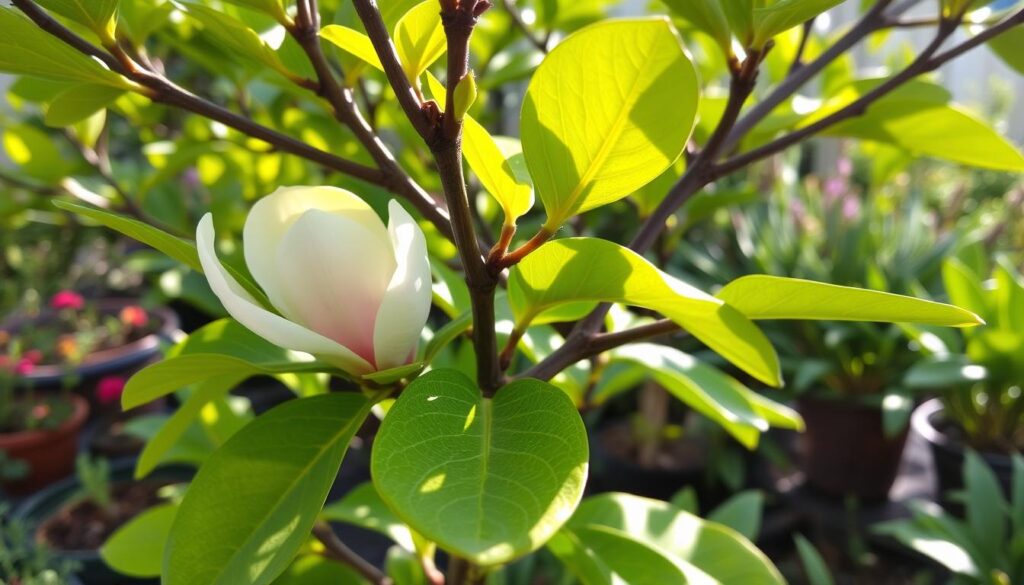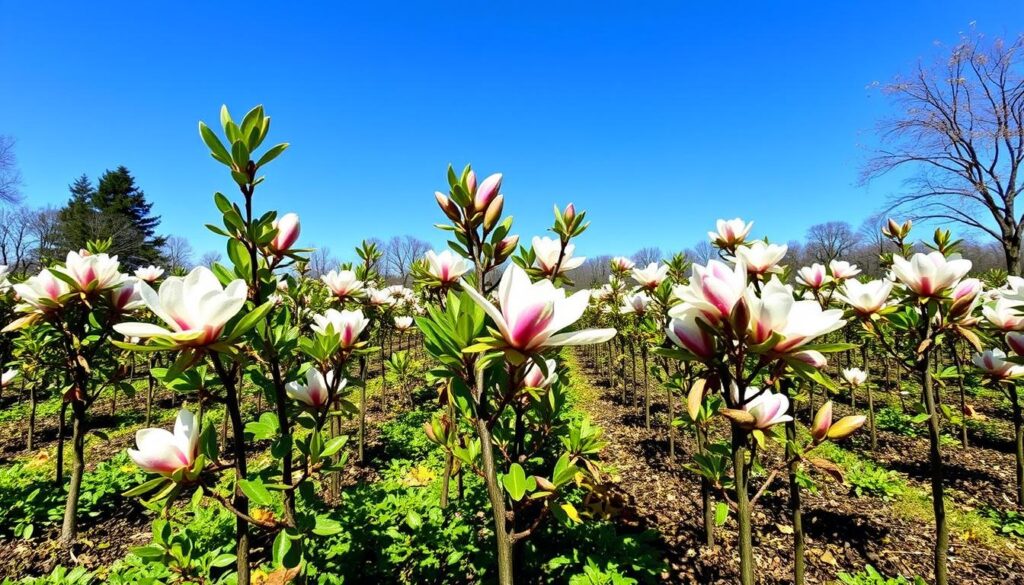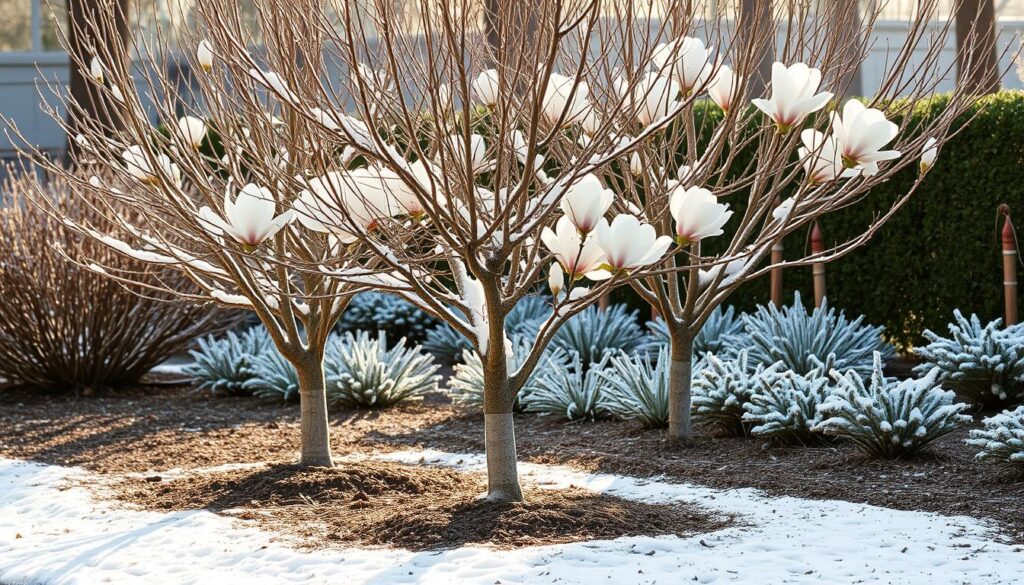Magnolia trees are a favorite among gardeners in Georgia. They are known for their stunning flowers and evergreen leaves. So how to Take Care of Baby Magnolia Trees in Georgia? For that, you need to know their specific needs. It’s important to give them the right conditions for growth.
Understanding these trees’ unique traits is key. You also need to provide the support they need to grow well.
Table of Contents
Key Takeaways
- Understanding the specific needs of baby magnolia trees is key for their growth.
- Magnolia tree care means giving them the right conditions, like proper watering and fertilization.
- Caring for baby magnolia trees requires attention to detail and dedication.
- Young trees need to be watered 1-2 times a week for the first 6 months after planting.
- Proper fertilization is also essential, with a balanced fertilizer recommended once a year.
- Protecting them from pests and diseases and providing support is also important.
- Magnolia tree care is a continuous process that needs dedication and attention.
Understanding Magnolia Trees and Their Varieties
Magnolia trees come in over 200 species and many cultivars. In Georgia, you can find popular types like the Southern Magnolia, Sweetbay Magnolia, and Saucer Magnolia. Each has its own look, like flower color and leaf shape.
If you want to grow baby magnolia trees, knowing the different types is key. You need to think about sun, soil, and water. With the right care, magnolia tree varieties can bloom beautifully and enhance your garden.
- Southern Magnolia (M. grandiflora)
- Sweetbay Magnolia (M. virginiana)
- Saucer Magnolia (M. x soulangeana)
These varieties have different features, from big flowers to small growth. Picking the right baby magnolia trees for your garden means enjoying their beauty for many years.
Ideal Planting Conditions for Baby Magnolias
When planting baby magnolias, picking the right spot and soil is key. They love full sun to partial shade and need well-draining soil rich in organic matter. The best soil for magnolias is slightly acidic, with a pH between 6.0 and 6.5.
The magnolia tree soil requirements are specific. The soil should be moist but not too wet. Here are some important things to think about when picking a spot for your baby magnolia:
- Full sun to partial shade
- Well-draining soil with a pH between 6.0 and 6.5
- Rich in organic matter
- Moderate watering, with 1 to 2 times a week for the first 6 months after planting
By picking the right spot and soil, your baby magnolia will thrive. It will give you beautiful flowers and leaves for many years. Don’t forget to water it regularly, but don’t overdo it. Too much water can harm it.
| Soil Type | pH Level | Organic Matter |
|---|---|---|
| Clay | 6.0-6.5 | High |
| Sandy | 6.0-6.5 | Low |
| Loam | 6.0-6.5 | Moderate |
Watering Practices for Young Magnolia Trees
Watering baby magnolias is key to their health. How often you water depends on the weather, soil, and tree age. Baby magnolias usually need water once or twice a week, based on the weather.
Don’t overwater, as it can cause root rot. Signs of not enough water include yellow leaves. Too much water makes leaves droopy and the trunk soft. Start with a deep watering of 5 seconds per gallon of the tree’s pot size.
For ongoing care, follow these tips:
- Water young magnolia trees 1 to 2 times per week for the first 6 months after planting.
- After the initial 6 months, magnolias typically only need watering during periods of extreme drought.
- Use 2 to 3 gallons of water for every inch of trunk diameter during each watering session.
By following these guidelines and knowing your magnolia’s needs, you can ensure it gets the right water to grow well.
| Tree Age | Watering Frequency | Watering Quantity |
|---|---|---|
| 0-6 months | 1-2 times per week | 5 seconds per gallon size of nursery pot |
| 6 months and older | As needed during drought | 2-3 gallons per inch of trunk diameter |
Fertilizing Baby Magnolia Trees
Fertilizing baby magnolias is key for their growth. It’s important to pick the right fertilizer. A balanced, slow-release fertilizer with equal nitrogen, phosphorus, and potassium is best. Apply it in late March or early April.
When you fertilize, always follow the package instructions. Don’t overdo it, as it can harm the tree. Fertilize once a year with a balanced fertilizer like 14-14-14 or 10-10-10. Spread it 10 inches from the trunk to cover the wide roots.
Some important tips for fertilizing baby magnolias include:
* Use a balanced, slow-release fertilizer.
* Apply it in the early growing season.
* Always follow the fertilizer package instructions.
* Avoid overfertilizing.
* Spread fertilizer 10 inches from the trunk base.
| Fertilizer Type | Application Time | Frequency |
|---|---|---|
| Balanced, slow-release | Early growing season | Once a year |
By following these tips and using the right fertilizer, your baby magnolias will get the nutrients they need. This makes fertilizing a success for their growth and health.
Pruning Techniques for Young Magnolias
Pruning baby magnolias is key to their care. It keeps the tree’s shape, promotes growth, and boosts blooming. The best time to prune is in late winter or early spring, before new growth starts.
For pruning baby magnolias, you need the right tools. Use sharp, clean pruning shears or loppers for precise cuts. Remove dead, diseased, or damaged branches, and any that cross or rub against each other.
When to Prune Baby Magnolias
The best time for magnolia tree pruning techniques is late winter or early spring. This lets the tree heal fast and lowers disease or pest risks.
Tools Needed for Pruning
Here are the tools you’ll need for pruning baby magnolias:
- Sharp, clean pruning shears
- Loppers for larger branches
- Gloves to protect hands from thorns
By using these pruning baby magnolias techniques and tools, your young magnolia tree will grow strong and healthy. It will also bloom beautifully for many years.
| Pruning Tool | Description |
|---|---|
| Pruning Shears | Used for cutting small branches and shaping the tree |
| Loppers | Used for cutting larger branches and removing dead or diseased wood |
Pest and Disease Management
Effective pest management is key for baby magnolia trees’ health. Regular checks can spot problems early. Pests like aphids, scale, and spider mites can harm them. Magnolia tree diseases like root rot and leaf spot are also threats.
To keep trees healthy, maintain good hygiene, water well, and feed them right. Use organic or chemical treatments as needed. For example, insecticidal soap and neem oil fight pests. Fungicides help with diseases like root rot.

- Regularly check the tree for pests or diseases
- Remove any infected or damaged branches
- Ensure the tree gets enough water and nutrients
- Use organic or chemical treatments when necessary
By being proactive with pest management and magnolia tree diseases, gardeners can keep their trees healthy and beautiful for years.
Mulching for Healthy Magnolia Trees
Mulching is key to keeping magnolia trees healthy. It helps keep the soil moist, stops weeds, and keeps the soil temperature right. Young magnolia trees need this extra care because they’re more prone to problems.
There are many mulch types to choose from. Pine straw, wood chips, and bark are popular. They keep the soil moist, stop weeds, and look nice. But, pick a mulch that’s weed-free and won’t harm the tree’s roots.
Benefits of Mulching
- Retains moisture and reduces the need for frequent watering
- Suppresses weeds and reduces competition for nutrients
- Regulates soil temperature and protects the tree from extreme temperatures
Recommended Mulch Materials
Here are some good mulches for magnolia trees:
- Pine straw: a popular choice for its acidity and ability to retain moisture
- Wood chips: a good option for its decorative appearance and ability to suppress weeds
- Bark: a durable and long-lasting option that can help regulate soil temperature
Apply 2-3 inches of mulch around the tree, but keep it away from the trunk. This helps your magnolia tree grow well. Mulching also means you might not need to use as many fertilizers and pesticides, which is better for the environment.
| Mulch Material | Benefits | Drawbacks |
|---|---|---|
| Pine Straw | Retains moisture, suppresses weeds | May be too acidic for some soil types |
| Wood Chips | Decorative, suppresses weeds | May attract pests, can be expensive |
| Bark | Durable, regulates soil temperature | Can be heavy, may compact soil |
Seasonal Care Tips for Magnolias
As the seasons change, it’s key to adjust your care for your magnolia tree. This ensures it stays healthy and beautiful. Proper care is vital for your tree’s well-being.
In the fall, cut back on watering and fertilizing. This lets the tree rest for the cold months ahead. In spring, start watering and fertilizing again. This helps it grow and bloom well.
Fall Care for Baby Magnolias
For baby magnolias in fall, water and fertilize less. This saves energy for the cold months. Also, mulch around the tree to keep moisture in and diseases out.
Spring Prep and Maintenance
In spring, water and fertilize regularly again. This supports growth and blooms. Prune the tree too, to keep its shape and air flowing. Pruning fights off diseases and pests.
Some key seasonal care tips are:
- Watering: Cut back in fall, then water regularly in spring.
- Fertilization: Fertilize in spring for growth and blooms.
- Mulching: Mulch to keep moisture in and diseases away.
- Pruning: Prune in spring to shape and air out the tree.

Follow these tips to keep your magnolia tree healthy and vibrant. Always focus on proper care for its long-term health and beauty.
| Season | Care Tips |
|---|---|
| Fall | Reduce watering and fertilization, mulch around the tree |
| Spring | Resume regular watering and fertilization, prune the tree |
Monitoring Growth and Health
Watching how baby magnolias grow and stay healthy is key to caring for them. By keeping an eye on the tree, gardeners can spot problems early. This way, they can fix issues quickly to keep the tree thriving.
Healthy magnolias have a strong canopy, bright leaves, and lots of flowers. To keep them healthy, gardeners should look for these signs. This includes a full canopy, green leaves, and plenty of blooms.
- A full, lush canopy
- Vibrant, green foliage
- Abundant blooming
To learn more about caring for baby magnolias, check out housegardenia.com. They have tips on monitoring growth and keeping magnolia tree health in top shape.
Ensuring Winter Survival
As winter comes, it’s key to protect baby magnolia trees. Keeping them warm is a top priority. You can use mulch, anti-desiccant sprays, or frost blankets to do this.
Experts say that caring for magnolias in winter means less water and fertilizer. It’s also important to watch the tree closely and act fast if needed.

Protecting Baby Magnolias from Cold
To keep baby magnolias warm, gardeners can try a few things:
- Apply a layer of mulch around the base of the tree
- Use anti-desiccant sprays to prevent moisture loss
- Cover the tree with a frost blanket to protect it from frost damage
Winterization Techniques
There are more ways to help your magnolia tree make it through winter. Reduce watering and fertilizing. Also, prune the tree to keep it healthy and looking good.
Encouraging Blooms in Young Magnolia Trees
To enjoy the stunning blooms of your baby magnolia trees, it’s important to understand the factors that influence their flowering. Young magnolias may take up to 10 years to reach full maturity and begin producing flowers. But, there are several techniques you can employ to promote earlier and more abundant blooms.
Factors Influencing Flowering
The age and overall health of the magnolia tree play a significant role in its ability to flower. Providing ample water, nutrients, and proper pruning can all contribute to a young tree’s vigor. This sets the stage for robust blooming. Environmental conditions, such as sunlight exposure and temperature, also impact a magnolia’s flowering cycle.
Tips for Promoting Early Blooms
To encourage your baby magnolias to flower more quickly, consider using bloom-promoting fertilizers or supplements designed for magnolias. Regular, deep watering during dry spells and consistent mulching around the root zone can also help stimulate flower production. Strategic pruning to maintain the tree’s natural shape and remove any competing growth can direct the plant’s energy toward blooming.
With patience, proper care, and a little extra attention, you can look forward to the captivating sights and intoxicating fragrances of your baby magnolia trees’ vibrant flowers in the years to come.
Frequently Asked Questions
How do you prune a baby magnolia tree?
Baby magnolias don’t need much pruning. In the first few years, only trim dead, damaged, or weak branches to help shape the tree. If you need to encourage strong growth, remove any crossing or inward-growing branches. Avoid heavy pruning, as young magnolias are sensitive and slow to recover.
How do you take care of magnolia seedlings?
Magnolia seedlings need moist, well-draining soil and partial to full sun. Keep the soil slightly damp but not soggy. Since young magnolias have delicate roots, avoid disturbing them. Adding mulch around the base (but not touching the trunk) helps keep moisture in and protects the roots.
How long does it take for a Magnolia ‘Little Gem’ to grow?
‘Little Gem’ magnolias are slow to moderate growers, adding about 1 to 2 feet per year. They reach about 20-25 feet tall in 10 to 20 years, depending on growing conditions.
Do magnolia trees grow well in Georgia?
Yes! Magnolia trees thrive in Georgia’s warm climate and well-draining soil. Southern magnolias, including ‘Little Gem’ and other varieties, do especially well in zones 7-9, which covers most of Georgia. Just make sure they get plenty of sun and moisture for the best growth.
How do you take care of a small magnolia tree?
Water regularly (especially in the first few years). Keep the soil moist but not soggy.
Mulch around the base to protect roots and retain moisture.
Give it enough sunlight—most magnolias prefer full sun to partial shade.
Fertilize in early spring with a balanced fertilizer to encourage healthy growth.
Minimal pruning—only remove dead or damaged branches to shape the tree.
How do you dig up a magnolia sapling?
If you need to transplant a magnolia sapling, do it in late fall or early spring when the tree is dormant.
Water the tree well a day before digging to reduce stress.
Dig a wide hole around the sapling, keeping as much of the root ball intact as possible.
Gently lift the sapling, avoiding root damage.
Replant quickly in a new location with well-draining soil and plenty of sun.
Water deeply after transplanting and keep the soil moist while the tree adjusts.

